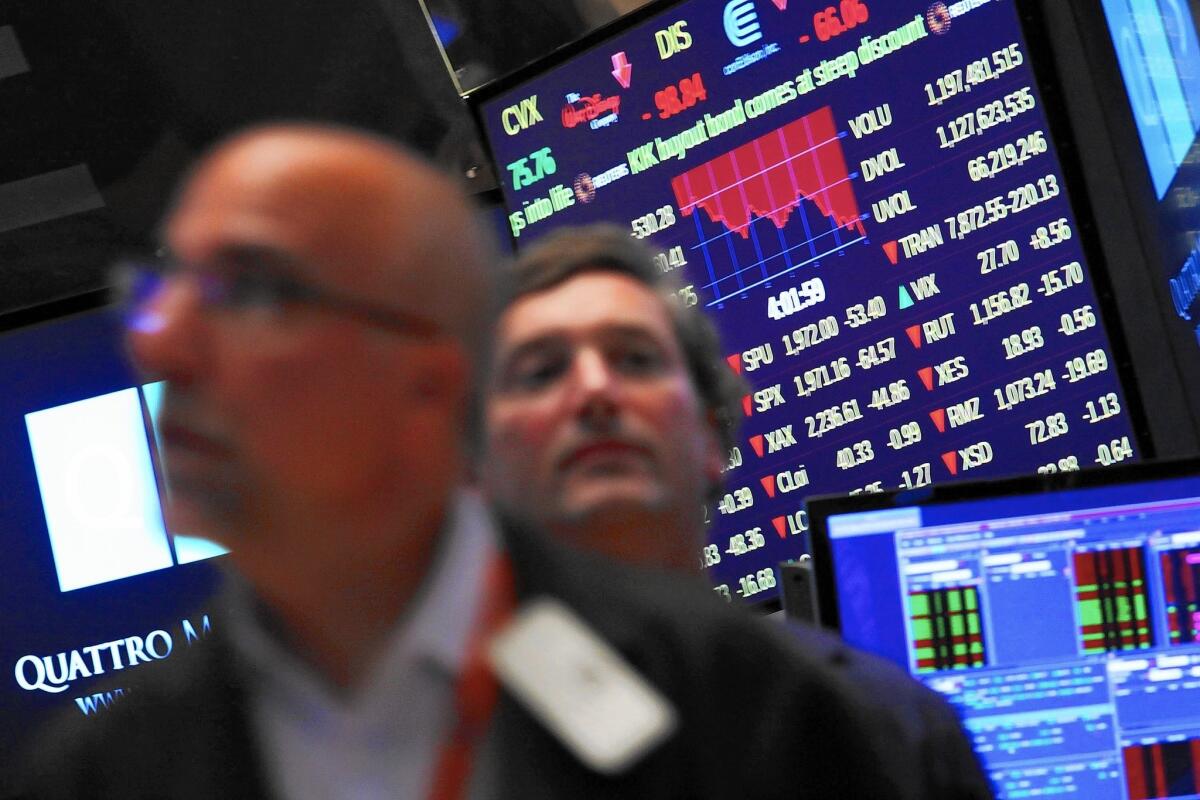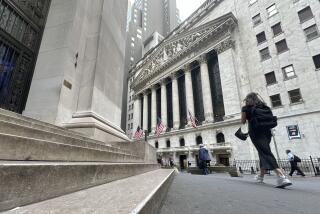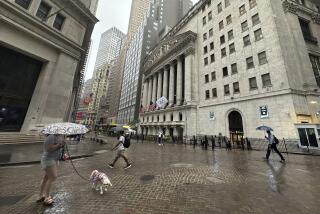Stock marketâs bumpy ride isnât over, experts say

Wall Streetâs wild week ended with relative calm, but no trader or money manager is betting the lull will last.
In one of the stock marketâs most chaotic periods in years, the benchmark Standard & Poorâs 500 first plunged 11.2% in just six sessions stretching into last week, then roared back 6.4% over the next two days before ending little changed Friday.
The Dow Jones average of 30 industrials plunged a stunning 1,000 points one day, then soared 1,000 points over only two days.
And the ride will probably stay rocky for a while, many veteran market watchers predict. âIt wouldnât surprise me to see many days in the next few weeks where we have more triple-digit moves [in the Dow] in both directions,â said Jeff Clark, a trading analyst at Stansberry Research.
No one can predict, of course, whether the marketâs next sustained move is up or down. Bear markets â a drop of 20% or more from the marketâs peak â are rare. But experts donât expect a quick recovery from the marketâs recent plunge, despite its head-turning rally last week.
âIn the 11 times since World War II that the market fell by 5% or more in August, it continued to fall in September 80% of the time, and did so an average of 4%,â said Sam Stovall, U.S. equity strategist at S&P Capital IQ.
And it can be tough to see a longer-term trend develop. After stocks tumbled early in 2008, for instance, they staged a recovery in the spring before the depth of the problems in the financial and housing markets became clear and sent stocks plummeting in the fall.
Even in down markets some industry sectors perform better than others, and that was true last week within the S&P 500âs sectors.
Tech, energy and âconsumer discretionaryâ stock sectors, including automakers such as Ford Motor Co., home builders such as Lennar Corp. and retailers such as Amazon.com, finished with gains.
But that sector and others were punished so badly earlier in the month that all 10 sectors joined the S&P 500 index in the red for the month to date.
âThe sectors that held up best â as Capt. Renault from âCasablancaâ said â were the usual suspects,â Stovall said.
They included so-called defensive sectors such as telecom, consumer staples and utilities whose products and services remain in demand even as global economies and markets are abruptly shifting, he said.
The consumer staples sector includes food and beverage stocks such as PepsiCo Inc. and personal-products firms such as Kimberly-Clark Corp.
âWhen times are challenging, itâs usually those defensive areas that fare well,â Stovall said.
Individual investors typically are cautioned against trying to time the market, because invariably they bail out when prices are low and return after prices already have rallied.
One alternative is to rebalance their portfolios with these types of defensive stocks â so that they stay invested and wonât lose out on all the gains if the market rises, analysts said.
Utilities showed the smallest loss, 2.1%, among the sectors for the month so far. Thatâs partly because many of those stocks already had dropped back this year after a strong 2014, said Joe DeSantis, a chief investment officer at Fidelity Investments.
Utilities in the S&P 500 include Rosemead-based Edison International, parent of Southern California Edison, and San Diego-based Sempra Energy.
Last week, as the market snapped back from its earlier rout, âthose sectors that did the best were those that had taken it on the chin the most: technology, energy and the financial stocks,â Stovall said. The tech-stock sector includes Apple Inc., Intel Corp. and Qualcomm Inc.
Utilities remain a good defensive play when âyou have a really unstable market,â partly because many utilities offer attractive dividend yields, DeSantis said.
But no sector could escape the marketâs recent turbulence. The marketâs initial plunge, coming after stocks had enjoyed a bull run over most of the last six years, pushed the S&P 500 and other major averages into a âcorrection,â or a drop of 10% or more.
Although the market erased a good part of that decline Wednesday and Thursday, analysts warned that the impact of a correction on stock prices â and investorsâ psyches â doesnât vanish quickly and more volatility is almost certain.
âThereâs been technical damage done to the market,â said Stansberry Researchâs Clark. âIt would be silly to think weâre going to run up again to all-time highs all of a sudden.
âItâs as though youâre sitting in a calm pool of water and somebody jumps in; it takes a while to settle,â he said.
The marketâs rebound was encouraging, âbut I wouldnât interpret it as saying, âWeâve hit the bottom, itâs off to the races and we can forget about the ugliness of earlier this month,ââ said David Dietze, president of Point View Wealth Management in Summit, N.J.
The two main issues are Chinaâs slowing economy and uncertainty as to whether the Federal Reserve will start lifting its benchmark U.S. interest rate, currently near zero, starting next month.
Recent gains in several areas of the U.S. economy indicate the central bank might go ahead and raise rates. But amid Chinaâs woes and the financial marketsâ turbulence, some speculate that the Fed will continue to wait.
Sectors less influenced, at least for now, by China and the marketâs wild swings are another defensive way to stay invested, analysts said.
Oppenheimer & Co. likes several stocks in the consumer-discretionary sector, such as Home Depot Inc. and Best Buy Co., because U.S. economic trends mainly âtend to drive [consumer] spendingâ at those stores.
But regardless of whether itâs China or other pressures weighing on the market, âit typically takes five months for the correction to bottom and four months to get back to break-even,â Stovall said.
âWeâve really only been in this correction for about three months because [the S&P 500] peaked on May 21,â he said. âItâs not going to be over any time soon.â
[email protected]
Twitter: @PeltzLATimes
ALSO:
Obama to rename Mt. McKinley as Denali
Taxpayers have never paid more for public worker pensions, but itâs still not enough
Kentucky clerk who opposes same-sex marriage turns to Supreme Court for help
More to Read
Inside the business of entertainment
The Wide Shot brings you news, analysis and insights on everything from streaming wars to production â and what it all means for the future.
You may occasionally receive promotional content from the Los Angeles Times.











